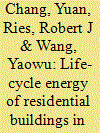|
|
|
Sort Order |
|
|
|
Items / Page
|
|
|
|
|
|
|
| Srl | Item |
| 1 |
ID:
099243


|
|
|
|
|
| Publication |
2010.
|
| Summary/Abstract |
A complete understanding of the resource consumption, embodied energy, and environmental emissions of civil projects in China is difficult due to the lack of comprehensive national statistics. To quantitatively assess the energy and environmental impacts of civil construction at a macro-level, this study developed a 24 sector environmental input-output life-cycle assessment model (I-O LCA) based on 2002 Chinese national economic and environmental data. The model generates an economy-wide inventory of energy use and environmental emissions. Estimates based on the level of economic activity related to planned future civil works in 2015 are made. Results indicate that the embodied energy of construction projects accounts for nearly one-sixth of the total economy's energy consumption in 2007, and may account for approximately one-fifth of the total energy use by 2015. This energy consumption is dominated by coal and oil consumptions. Energy-related emissions are the main polluters of the country's atmosphere and environment. If the industry's energy use and manufacturing techniques remain the same as in 2002, challenges to the goals for total energy consumption in China will appear in the next decade. Thus, effective implementation of efficient energy technologies and regulations are indispensable for achieving China's energy and environmental quality goals.
|
|
|
|
|
|
|
|
|
|
|
|
|
|
|
|
| 2 |
ID:
125761


|
|
|
|
|
| Publication |
2013.
|
| Summary/Abstract |
In the context of rapid urbanization and new construction in rural China, residential building energy consumption has the potential to increase with the expected increase in demand. A process-based hybrid life-cycle assessment model is used to quantify the life-cycle energy use for both urban and rural residential buildings in China and determine the energy use characteristics of each life cycle phase. An input-output model for the pre-use phases is based on 2007 Chinese economic benchmark data. A process-based life-cycle assessment model for estimating the operation and demolition phases uses historical energy-intensity data. Results show that operation energy in both urban and rural residential buildings is dominant and varies from 75% to 86% of life cycle energy respectively. Gaps in living standards as well as differences in building structure and materials result in a life-cycle energy intensity of urban residential buildings that is 20% higher than that of rural residential buildings. The life-cycle energy of urban residential buildings is most sensitive to the reduction of operational energy intensity excluding heating energy which depends on both the occupants' energy-saving behavior as well as the performance of the building itself.
|
|
|
|
|
|
|
|
|
|
|
|
|
|
|
|
| 3 |
ID:
109670


|
|
|
|
|
| Publication |
2011.
|
| Summary/Abstract |
With rapid social development and large-scale construction of infrastructure in China, construction projects have become one of the driving forces for the national economy, whose energy consumption, environmental emissions, and social impacts are significant. To completely understand the role of construction projects in Chinese society, this study developed input-output life-cycle assessment models based on 2002, 2005, and 2007 economic benchmarks. Inventory indicators included 10 types of energy, 7 kinds of environmental emissions, and 7 kinds of social impacts. Results show that embodied energy of construction projects in China accounts for 25-30% of total energy consumption; embodied SO2 emissions are being controlled, and the intensities of embodied NOx and CO2 have been reduced. However, given that the construction sector related employment is 17% of the total employment in China, the accidents and fatalities related to the construction sector are significant and represent approximately 50% of the national total. The embodied human and capital investments in science and technology (ST) increased from 2002 to 2007. The embodied full time equivalent (FTE) of each ST person also increased while the personal ST funding and intramural expenditures decreased. This might result from the time lag between RD activities and large-scale implementation.
|
|
|
|
|
|
|
|
|
|
|
|
|
|
|
|
|
|
|
|
|